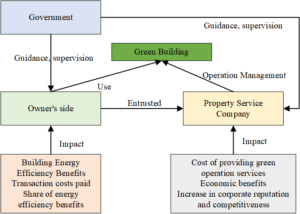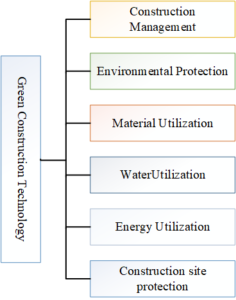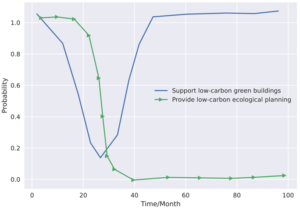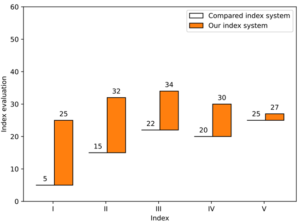With the development of social economy, urban planning has been paid more and more attention. At present, China is implementing low-carbon environmental planning in stages, stages and stages with the development goal of building two types of society, namely, national master plan and strategic development. This paper analyzes low-carbon environmental planning based on blockchain, then expounds the specific content of whole process project management, and completes the design of green building index system based on low-carbon environmental planning. At the same time, the design method of new dynamic structure and index system of green building is expounded. The comparative analysis shows that the material loss cost of the new environmental protection building engineering and index system is low, and the material utilization rate is high, accounting for more than 95%.
With GDP increasing from 364.5 billion yuan in 1978 to 101,598.6 billion yuan in 2020, creating a “Chinese speed” [1]. This world-renowned achievement cannot be achieved without the support of the traditional construction industry, but the industrial development mode of the construction industry with high energy consumption has led to very prominent environmental pollution problems [2]. Maintaining the sustainable growth of the construction industry, effectively improving the environment and using resources to achieve sustainable development of society has become a common concern of the whole society [3]. Green innovation building, on the other hand, provides new ideas to solve this social problem, and it is expected to become a new engine of world economic development [4]. Innovation is the first driving force to lead development and the strategic support to shape the modern economic system, and to promote green development and establish a market-oriented green technology innovation system [5,6]. Innovation driven industrial green transformation will become the main theme. Combined with the national innovation driven development strategy and green development, Green innovation building should become the key choice for China to develop green transformation and the key to develop a high-quality economy [7].
In [8], they clearly points out that “developing a low-carbon economy is not only a global responsibility, but also a stage for competition and technological innovation among countries. In [9,10], the concept of” low-carbon city “was introduced,” sink construction and zero carbon construction, carbon testing, low-carbon monitoring and other departments were widely carried out, and the concept of “green low-carbon city” was gradually introduced.
The whole process project management level of the operation stage has an important influence on the realization of “true green” green building [11,12]. Green building dynamic construction is the use of green, advanced and effective management methods to manage the green buildings that are put into operation after completion, to achieve the expected goals of green building design [13,14]. Green building dynamic construction includes management objectives, management functions, management methods, management costs, and management participants [15].
Cities at home and abroad have incorporated low-carbon ecological concepts in their architectural design, such as Tianjin Eco-city and Abu Dhabi Masdar in the United Arab Emirates . Low-carbon ecology refers to the use of low-carbon technologies, such as renewable energy, transportation construction, etc., and urban planning as an outline to develop regulatory mechanisms in land and transportation, thus reflecting the concept of low-carbon ecology and “action” in green cities . The details are in Table 1.
| Category Fields | Action Points |
| Land | Choose TOD model to achieve density and compact building development goals |
| Transportation | BRT technology and bicycle programs, green mobility programs, and smart transit systems |
| Energy | Smart grid, LED lighting, renewable energy |
| Green | Conservation mechanisms, eco-neighborhoods, and disaster prevention |
| Construction | Rooftop retrofits, building ratings, and retrofit support programs |
The relevant interest subjects involved in the dynamic construction of green building include owner side, builder service enterprise and government, etc. The relationship among the three is shown in Figure 1.

The owner is the user of the green building and the house whole process project management and related supporting facilities by selecting and hiring the builder service enterprise, therefore, the owner is the direct beneficiary of the green building dynamic construction. In the dynamic construction of green building, the owner is more concerned about the energy saving benefit of the building and whether the building meets the performance. The owner’s behavior depends on the cost paid by the builder service company. When the benefits of supporting green building dynamics outweigh the costs, owners will choose to support green building dynamics.
Among the subjects involved, meeting the interests of owners and builder service enterprises is the key, and the government plays a guiding and supervisory role in the game of interests between them. For the builder service enterprises, they cannot directly obtain the income brought by building energy saving, while providing green builder service will pay more costs, and if they cannot get a certain amount of compensation from the owner side, they will be reluctant to spend time, energy and money to improve their own green builder management level. For the owner side, it cannot clearly understand the benefits brought by building energy efficiency and is often reluctant to share part of the energy efficiency benefits to the builder service companies. Thus, it is clear that the interests between the two key subjects are not coordinated, and the government can balance the conflicting interests of the owner side and the builder service companies through incentives and penalties, so that the positions of both sides can shift toward green operations. This paper further investigates the structure of green construction technology, which is shown in Figure 2.

As shown in Figure 2, at the present stage of efficient management of construction projects in China, green construction technology mainly includes six basic indicators of management, which can improve the quality of construction in an all-round way. The dynamic management of construction project of green construction technology, as an important part of guaranteeing the quality and progress of project site implementation, through dynamic management plan, dynamic management implementation and dynamic management inspection, the whole construction site is comprehensively managed to obtain the problems existing in each construction stage and improve them combined with the requirements of green environment protection to form a good construction cycle.
For the system, the setting and supervision of its design ideas should be predicted and evaluated as the premise, and through the representation of the abstract object attributes and characteristics, so that it can form an operable and behavioral structure model, and through the advantages and performance of the elements of the index system components are given, so as to reflect the weight of the index system design work. Regardless of the development of any project work, should have the guiding tools and conditions, and during the green building design, the guiding standards should be developed under the generalization and implementation of the indicator system ideas. At this stage, the current national index system is mainly oriented to the development of “urban low-carbon”, through “planning guidance”, “index control”, “index implementation” and “index implementation”. Through the control methods of “indicator implementation” and “indicator verification”, low-carbon ecology and green building are used as the purpose of the indicator system and development is implemented through continuous strengthening and efforts in the implementation of the construction program.
Based on the above analysis and relevant assumptions on the green building behavior of the building body, the evolution payment matrix between the owner and the construction service industry is established, as shown in Table 2.
| Owners | Property service companies | – |
| – | Provide green property management services(y ) | Providing traditional property management services (1-y ) |
| Support Green Operation Management (x ) |
|
|
| Do not support green operation management (1- x ) |
|
|
The expected benefits
The expected benefits
The five local equilibrium points for the evolution of the system can
be found by combining Eq. (4) and Eq. (8): (0, 0), (0,
1), (1, 0), (1, 1),
The above equilibrium points show that the behavior of green building dynamic construction subjects is related to the amount of benefit sharing, the cost spent by both parties involved, the excess revenue of builders’ service enterprises, and the amount of government rewards and penalties. In this paper, the system dynamics simulation tool will be used to construct a model of green building and its index system design for owner and builder service enterprises, analyze the evolutionary trend of the behavior of both sides of the game, and test its stability. Then, from the perspective of the government, the impact of this mechanism on the behavior of both parties of interest is simulated to improve the effectiveness of the dynamic construction of green buildings.
The dynamic construction of green building and its index system design model constructed in this paper mainly consists of 2 rate variables, 2 level variables and 17 auxiliary variables as in Figure 3.

In this paper, we will choose pure strategy (1, 1) and mixed strategy (0.5, 0.5) to simulate and analyze the dynamic construction of green building and its index system design.
When the owner and the builder service enterprise adopt the strategy of supporting green dynamic construction and providing green builder management service with 100% probability respectively, i.e., using the pure strategy (1, 1), the simulation results show that the probability of both parties is kept at 1. The stability of this strategy is verified with the strategy (0.99, 0.99), and its simulation results are shown in Figure 4.

From Figure 4, it can be seen that when the probability of supporting green dynamic construction and providing green builder services change by 1% respectively, the probability of the owner side supporting green dynamic construction decreases at the beginning, decreases to a certain degree, increases again and finally reaches 1 with time. And the probability of builder service companies providing green builder services changed significantly, kept on a decreasing trend, and finally reached 0; through the above comparative analysis it is known that the pure strategy (1, 1) is unstable.
When the owner and the builder service enterprise adopt the strategy of supporting green dynamic construction and providing green builder management service with 50% probability respectively, i.e., the our strategy (0.5, 0.5), the stability of this our strategy is verified with the strategy (0.49, 0.49), and the simulation results of the evolutionary game process are shown in Figure 5.

From Figure 5, it can be seen that with the our strategy (0.5, 0.5), the probability of supporting green dynamic construction gradually increases and tends to 1 and the probability of providing green builder services gradually decreases and tends to 0 with time, and the evolution path of the strategy (0.49, 0.49) is basically the same, so the our strategy is stable.
The main objectives of this test are two: to control the waste emission from the site construction and to maximize the saving of construction materials and natural resources. Firstly, based on the theory of green construction technology, the site implementation of the construction project is analyzed in all aspects, and the project site implementation is divided into foundation construction, structure construction and decoration construction with the division principle of phased arrangement. Combining with the site implementation plan, it sets the dynamic management target of site implementation, fully considers the site environment, plans the construction road, construction area, construction material processing, etc., and dynamically manages the construction site layout of the project. Based on the arrangement of the site implementation site facilities of the project, site hardening treatment is carried out for all soil areas of the construction site to avoid sand lifting caused by unstable soil and pollution of the environment around the construction site, as well as avoiding the waste of soil caused by sand lifting. In the site hardening treatment, different hard treatment methods are used for roads of different purposes.
For the general auxiliary roads in construction projects, the test uses 100mm thick C15 plain concrete for hardening treatment; non-traffic roads are treated with greening instead of hardening to achieve the goal of green environment protection while protecting the construction soil environment. In the dynamic management of the construction site, all construction materials are scheduled and planned to control the use of building materials to ensure the quality of construction while achieving the goal of green construction management. In Figure 6, we compare the index system in this paper with that in literature [15]. The results show that the system in this paper is more effective in evaluating the index system.

Low-carbon ecological city construction to cope with climate issues to be examined, the reason is: climate change is a key factor affecting the social economy. During the implementation of socialist culture in China, it is necessary to slow down the pressure of energy intensification, and to use the association between low-carbon ecological planning and whole process project management, the design ideas of indicator system, and the clear way of implementing the indicator system to take the low-carbon ecological green building indicator system as a development opportunity, so as to realize the characteristic city construction ideas in China.
All authors reviewed the results, approved the final version of the manuscript and agreed to publish it.
The authors declared that they have no conflicts of interest regarding this work.
The experimental data used to support the findings of this study are available from the corresponding author upon request.
The study was not supported by a grant.
Chen, L., Chan, A.P., Owusu, E.K., Darko, A. and Gao, X., 2022. Critical success factors for green building promotion: A systematic review and meta-analysis. Building and Environment, 207, p.108452.
Debrah, C., Chan, A.P. and Darko, A., 2022. Artificial intelligence in green building. Automation in Construction, 137, p.104192.
Guo, K., Li, Q., Zhang, L. and Wu, X., 2021. BIM-based green building evaluation and optimization: A case study. Journal of Cleaner Production, 320, p.128824.
Chandra, K., Marcano, A.S., Mumtaz, S., Prasad, R.V. and Christiansen, H.L., 2018. Unveiling capacity gains in ultradense networks: using mm-wave NOMA. IEEE Vehicular Technology Magazine, 13(2), pp.75-83.
Cao, M.Q., Liu, T.T., Zhu, Y.H., Shu, J.C. and Cao, M.S., 2022. Developing electromagnetic functional materials for green building. Journal of Building Engineering, 45, p.103496.
Abdelaal, F. and Guo, B.H., 2021. Knowledge, attitude and practice of green building design and assessment: New Zealand case. Building and Environment, 201, p.107960.
Palanisamy, S., Thangaraju, B., Khalaf, O.I., Alotaibi, Y., Alghamdi, S. and Alassery, F., 2021. A novel approach of design and analysis of a hexagonal fractal antenna array (HFAA) for next-generation wireless communication. Energies, 14(19), p.6204.
Alsubari, S.N., Deshmukh, S.N., Alqarni, A.A., Alsharif, N., Aldhyani, T.H., Alsaade, F.W. and Khalaf, O.I., 2022. Data analytics for the identification of fake reviews using supervised learning. Computers, Materials & Continua, 70(2), pp.3189-3204.
Wang, W., Tian, Z., Xi, W., Tan, Y.R. and Deng, Y., 2021. The influencing factors of China’s green building development: An analysis using RBF-WINGS method. Building and Environment, 188, p.107425.
Zhang, G., 2024. Enhancing English Pronunciation Assessment in Computer-Assisted Language Learning for College Students. Journal of Combinatorial Mathematics and Combinatorial Computing, 120, pp.275-283.
Gao, Y., Wang, B., Xu, P., Lv, Z., Jiao, J. and Liu, N., 2024. Big Data Analysis Based on the Evaluation of College Students’ Civic Web. Journal of Combinatorial Mathematics and Combinatorial Computing, 120, pp.265-274.
Guo, L. and Sun, Y., Economic Forecasting Analysis of High-Dimensional Multifractal Action Based on Financial Time Series. International Journal for Housing Science and Its Applications, 45, pp.11-19.
Altay, A. and Mirici, I.H., Efl Instructors’ Implementations of 21st Century Skills in Their Classes.
Wu, Y., Exploration of the Integration and Application of the Modern New Chinese Style Interior Design. International Journal for Housing Science and Its Applications, 45, pp.28-36.
Chen, P., Research on Business English Approaches from the Perspective of Cross-Cultural Communication Competence. International Journal for Housing Science and Its Applications, 45, pp.13-22.
1970-2025 CP (Manitoba, Canada) unless otherwise stated.